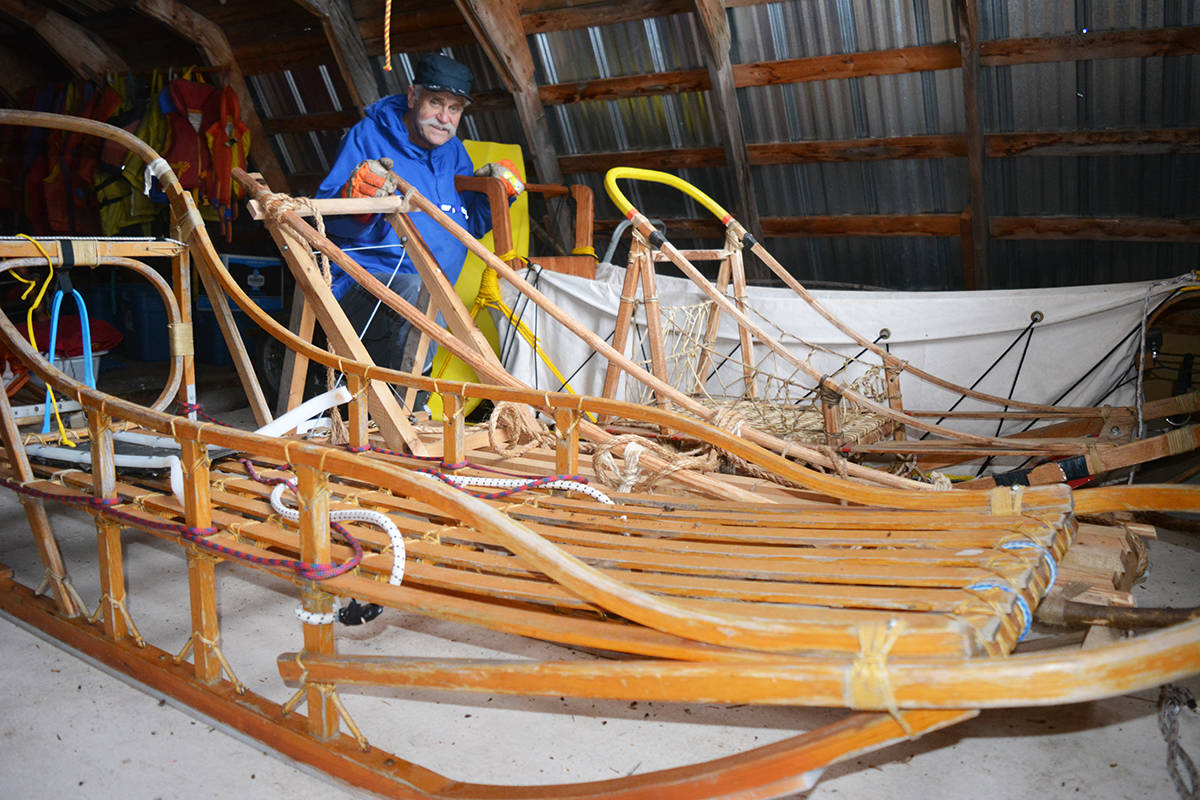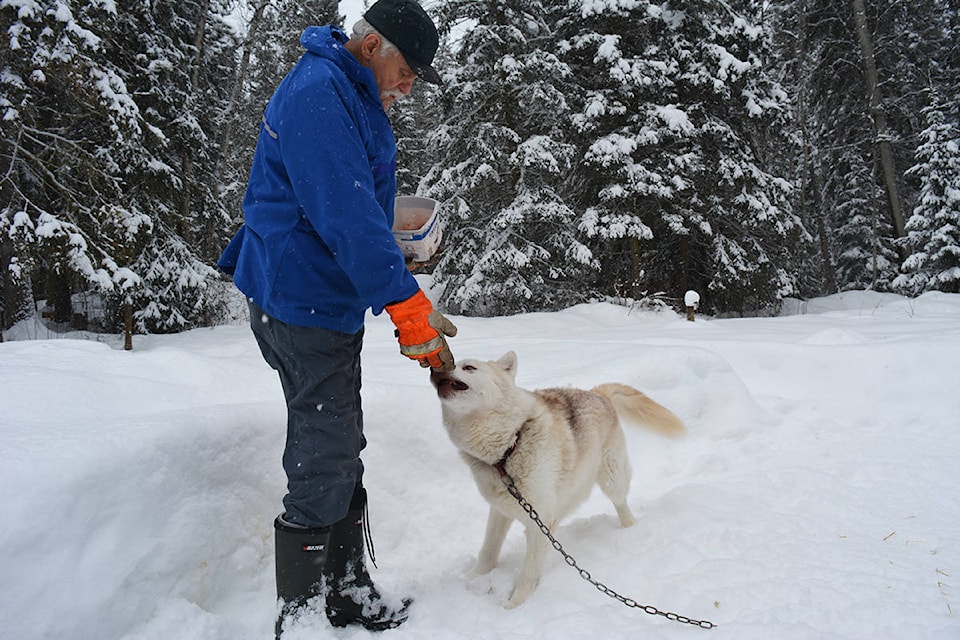When mushers are sworn in as official Canada Post mail carriers Friday, Jan. 24 in front of the Quesnel Post Office to officially begin the 28th Annual Gold Rush Trail Sled Dog Mail Run, they will kick off a much-loved Cariboo tradition.
They will also be re-living gold rush-era history, as they carry mail from Quesnel to Barkerville over three days.
The Gold Rush Trail Sled Dog Mail Run started in 1993 and has taken place every year since then.
Jeff Dinsdale, a mail run organizer and participant who has taken part in every single Gold Rush Trail Sled Dog Mail Run, says sled dogs were not actually a big part of the Cariboo gold rush or life in Barkerville in the 1860s, but they certainly did carry mail through Quesnel in the early 20th century.
“Now, to be totally honest, sled dogs were not a big part of the Cariboo Gold Rush, and it’s important also to keep in mind, when we are talking about mail and sled dogs, we’re talking about the delivery of mail in the winter,” said Dinsdale. “The First Nations in this area never had sled dogs; they never used them. The other reality is that the snow was simply too deep for almost anything, actually. Sled dogs were not a big part of the gold rush history, but sled dogs were a big part of delivering mail in Quesnel.”
Dinsdale points to a black and white photo of a dog team arriving in front of the post office at the old Hudson’s Bay Building on Front Street (which is currently home to Cariboo Keepsakes Local Arts and Crafts). He says the dog team would have brought the mail from Fort Fraser, north of here, and it would have travelled along the Collins Overland Telegraph Trail (COTT).
“The trail became a thoroughfare, and in the winter, dog teams used it as a route from Fort Fraser,” said Dinsdale. “The COTT, which was dated at 1866, became the Yukon Telegraph Trail. The COTT stopped being under construction when they laid the trans-Atlantic cable, but when they discovered gold in Yukon in Dawson City, there was a hue and cry from people for news of what was going on in the Klondike, and so they resurrected the COTT and they extended it all the way to Dawson City. It actually went right through Quesnel, and mail was hauled up and down that trail for years and years by dog team. So sled dogs were used in the Quesnel area to haul mail north and south.”
Dinsdale says delivering mail is a small part of what sled dogs have done over history, although they were used more up north than here.
The unsuccessful attempt to construct the Collins Overland Telegraph between North America and Russia in the late 1860s and the successful establishment of the Yukon Telegraph Line, using much of the abandoned Collins route, in the early years of the 20th century, created overland routes and linked communities, noted Dinsdale. The establishment of these routes, along with the Cariboo and Klondike gold rushes, established both a need for mail delivery and also rudimentary trails and paths that could be followed while delivering the mail.
Both the Collins Overland and the Yukon Telegraph lines pass through Quesnel, and Quesnel (once known as Quesnelle Mouth) was a major trans-shipment point for the delivery of goods of all kinds to the Barkerville gold fields, according to Dinsdale.
“The sled dogs that were brought into this area were brought into this area by the Hudson’s Bay Company, and that would be starting in the early 1800s, and then the use of sled dogs started to grow, and it was primarily because of the fur trade, and it was primarily because of those two telegraph lines that became major transportation routes, the COTT and the Yukon Telegraph, which superseded it,” said Dinsdale.
Dinsdale says there are documented records and photos of mail being delivered along the Yukon Telegraph Trail from the turn of the 20th century to the 1920s by dog team, and while mail was not delivered to the Barkerville area by dog team because the snowfall was too deep to make it practical, there are documented records of some miners using sled dogs in that area for their own personal use, travelling back and forth to their claims.
READ MORE: Your only chance to send mail by dog team is coming up this month
The dogs
As for himself, Dinsdale has been raising and working with sled dogs for almost 50 years.
On their honeymoon in 1972, Dinsdale and his wife, Margaret, moved to the Northwest Territories.
“We lived in a small community there where there were dog teams, and I saw my first dog team that winter and just fell in love with the whole idea of working dogs and the history of sled dogs,” said Dinsdale. “We got our first dog that year in 1972, and I’ve been raising sled dogs ever since then. Now I’m at the point where I only have three left. I haven’t bred dogs in over eight years, and one by one, they’ve passed away. It’s part of a plan to keep them until they all die and not get anymore.”
Jeff and Margaret have raised sled dogs since 1972, and at one point, they had a kennel with almost 30 dogs.
The Dinsdales’ dogs are Canadian Inuit dogs, which Dinsdale says are fairly rare.
“These are the dogs that are from the Canadian Arctic, used by the Inuit,” he said. “They are a registered breed with Canadian Kennel Club (CKC). The CKC refers to them as Canadian Eskimo Dogs, but I don’t think that whole thing, the registering of these dogs, has much credibility. The Inuit dog in my opinion is not really a breed. A breed is a man-made thing … the Inuit dog, rather than referring to it as a breed, I prefer to call it a land race. A land race is a living thing — so we’re not just talking about animals; we’re talking about plants too — that evolves in its own unique environment. It evolves in a way that allows it to adapt to the environment, and it is capable of reproducing itself. That’s a land race, and that’s what the Inuit dog was and is. It was a dog that evolved in the Arctic and is ideally adapted to the conditions that are part of life in the Arctic. You have these dogs with this incredible dense double coat and the ability to deal with the extreme rigours of life in the Arctic.”
Dinsdale describes the dogs as big — his are 90 pounds, which he says is usually about double what the other dogs in the mail run will be — with very distinctive temperaments, and they are not really racing dogs, as they are not particularly fast.
Dinsdale has been involved with Canadian Inuit dogs since the 1980s, and he says they had Siberian huskies for many years as well.
Dinsdale says the dogs we will primarily see at the mail run are not Inuit dogs or Siberian huskies.
“There will be some Siberian huskies, but the dogs you see on most dog teams now are simply referred to as Alaskan huskies,” he explained. “An Alaskan husky is essentially a mongrel that has been bred to absorb all of the features that would make it a good sled dog.”
Dinsdale says first of all, they have to have the attitude that they want to work and they just want to go. Second, they have to have really good feet because running over icy conditions can be very hard on any animal’s feet. Thirdly, they have to have a desire to eat because these dogs burn “incredible amounts of calories” when they are working and they need to be really willing to eat so they will eat happily when you give them food. Fourthly, people are looking for a fast dog. The fifth thing they are looking for is an ability to withstand cold temperatures, so primarily a double-coated dog.
Over the years, many skijorers have taken part in the Gold Rush Trail Sled Dog Mail Run, and Dinsdale says they often use dogs called Eurohounds. Dinsdale says the Eurohounds take part in sleddogsports, which consists of dog mushing, skijoring, canicross (which is being pulled by a dog while you are running), having dogs pull you on scooters and having dogs pull you on wheeled carts.
“These Eurohounds tend to be crosses involving either Greyhounds or German shorthaired pointers,” said Dinsdale. “They are amazing animals. The beautiful thing with these dogs is they are working all year round because a lot of these sports aren’t just snow-related.”
The Gold Rush Trail Sled Dog Mail Run takes place Jan. 23-26. For more information, visit sleddogmailrun.ca.
READ MORE: VIDEO: Special screening of Shadow Trap will wrap up Sled Dog Mail Run Jan. 26 in Wells
Lindsay Chung
email
Like the Quesnel Cariboo Observer on Facebook

